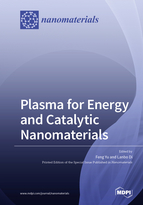Plasma for Energy and Catalytic Nanomaterials
A special issue of Nanomaterials (ISSN 2079-4991). This special issue belongs to the section "Energy and Catalysis".
Deadline for manuscript submissions: closed (20 August 2019) | Viewed by 56326
Special Issue Editors
Interests: cold plasma; nanomaterials; plasma chemistry; supported metal catalysts
Interests: micro/nano-structured nanomaterials and catalysts such as metal oxide, carbon materials, layered double hydroxides, metal–organic frameworks, etc.; building blocks in complex two-dimensional (2D) and three-dimensional (3D) integrated assemblies and regular architectures with porous structures; advanced catalytic nanomaterials in high-tech catalytic technology—especially for carbon neutralization, denitration, water splitting, etc.
Special Issue Information
Dear Colleagues,
Nanomaterials preparation is gaining increasing interest for energy and catalytic applications, such as methane reforming, Fischer-Tropsch synthesis, oxygen reduction reaction (ORR), hydrogen evolution reaction (HER), VOCs removal and CO preferential oxidation (PROX), etc. The plasma method allows thermodynamically and dynamically difficult reactions to proceed at low temperatures due to the activation of energetic electrons. Compared to conventional preparation methods, it has been proven to be a fast, facile and environmentally-friendly method for synthesizing highly-efficient nanomaterials. The synthesized nanomaterials generally show enhanced metal-support interactions, small sizes of metal nanoparticles, specific metal structures, abundant oxygen vacancies, etc. Therefore, they exhibit high catalytic activity and stability in energy and catalytic applications. In spite of the growing interest in plasma for energy and catalytic nanomaterials, synthesis mechanisms of nanomaterials using plasma still remains obscure due to the complicated physical and chemical reactions during plasma preparation. A great deal of research is needed to better understand the controllable preparation mechanisms of the plasma method and widen its application scope in synthesizing energy and catalytic nanomaterials. Submissions to this Special Issue are welcome in the form of original research papers or short reviews that cover the synthesis and applications of energy and catalytic nanomaterials by plasma.
Prof. Dr. Lanbo Di
Prof. Dr. Feng Yu
Guest Editors
Manuscript Submission Information
Manuscripts should be submitted online at www.mdpi.com by registering and logging in to this website. Once you are registered, click here to go to the submission form. Manuscripts can be submitted until the deadline. All submissions that pass pre-check are peer-reviewed. Accepted papers will be published continuously in the journal (as soon as accepted) and will be listed together on the special issue website. Research articles, review articles as well as short communications are invited. For planned papers, a title and short abstract (about 100 words) can be sent to the Editorial Office for announcement on this website.
Submitted manuscripts should not have been published previously, nor be under consideration for publication elsewhere (except conference proceedings papers). All manuscripts are thoroughly refereed through a single-blind peer-review process. A guide for authors and other relevant information for submission of manuscripts is available on the Instructions for Authors page. Nanomaterials is an international peer-reviewed open access semimonthly journal published by MDPI.
Please visit the Instructions for Authors page before submitting a manuscript. The Article Processing Charge (APC) for publication in this open access journal is 2900 CHF (Swiss Francs). Submitted papers should be well formatted and use good English. Authors may use MDPI's English editing service prior to publication or during author revisions.
Keywords
- Plasma
- Nanomaterials
- Catalytic applications
- Energy applications
- Dielectric barrier discharge








